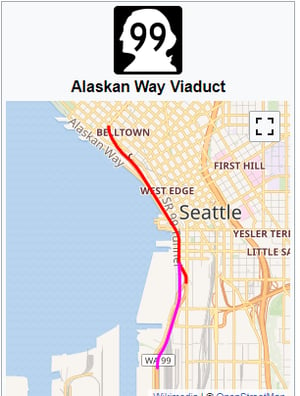
Heard at the workplace:
“Sorry I was late; the traffic was terrible. Viaduct? … they did what? Blew up the viaduct? I didn’t know. Guess I was paying too much attention to the Seahawks and missed the news.”
“I am going to work late today because I am an enthusiastic employee who wants to excel. Oh? The traffic and viaduct closure? … uh… no, that has nothing to do with me staying late, I want to stay and do extra work.”
If you have never driven on the viaduct, you have missed your opportunity. It is being demolished and replaced by a magnificent tunnel.
What is it?
The Alaskan Way Viaduct is an elevated freeway in Seattle, Washington, United States, carrying a section of State Route 99 (SR 99).
The double-decked freeway runs north–south along the city's waterfront for 2.2 miles (3.5 km), east of Alaskan Way and Elliott Bay, and travels between the West Seattle Freeway in SoDo and the Battery Street Tunnel in Belltown.
History
 The viaduct was built in three phases from 1949 through 1959, with the first section opening on April 4, 1953. It is the smaller of the two major north–south traffic corridors through Seattle (the other being Interstate 5), carrying up to 91,000 vehicles per day in 2016.[1] The viaduct runs above the surface street, Alaskan Way, from S. Nevada Street in the south to the entrance of Belltown's Battery Street Tunnel in the north, following previously existing railroad lines.
The viaduct was built in three phases from 1949 through 1959, with the first section opening on April 4, 1953. It is the smaller of the two major north–south traffic corridors through Seattle (the other being Interstate 5), carrying up to 91,000 vehicles per day in 2016.[1] The viaduct runs above the surface street, Alaskan Way, from S. Nevada Street in the south to the entrance of Belltown's Battery Street Tunnel in the north, following previously existing railroad lines.
The Traffic
The longest major highway closure the Puget Sound Region has ever seen begins 10 p.m. on Friday, Jan. 11, 2019 for approximately three weeks. State Route 99 will be closed from South Spokane Street to the south end of the Battery Street Tunnel.
A study by KING 5 found there are approximately 18,700 vehicles traveling northbound between 6 a.m. and 10 a.m. About 10,500 drivers use the Seneca Street and Western Avenue exits.
The Pain
Emissions, compassion and patience will be challenges for those on and off the road.
- “Dr. Phil Swartzendruber, air quality scientist for the Puget Sound Clean Air Agency, says aside from increased commute times, traffic gridlock increases pollution. If there's stop-and-go traffic, emissions go up.”
- SDOT’s Heather Marx says: ““This is going to be a really stressful time, but we have to be compassionate with each other, and we have to be compassionate with ourselves. That’s going to make things a lot safer for everybody, and also more comfortable.”
“Commute times will more than double!” These are the headlines from a local news agency. This should lead to more coffee, more people on their cell phones (illegally), more texting (again illegally).
Seattleites already have a reputation for being among the worst drivers in the nation. It’s something locals have known for years and a study from Allstate has confirmed. Seattle drivers are just the worst. Emerald City motorists ranked 184th on Allstate’s Best Drivers Report, just 16 spots from dead last. Closing the viaduct will certainly test this theory.
Travel solutions are available
WSDOT has a fairly extensive resource for showing the timetables, optional routes and what to think about during the closure. Check it out here.
There is an app for that! You can use an app to check local traffic. Google app here and Apple app here. I am unsure of how helpful it will be since we are expecting red traffic zones which the app will confirm. What it can be helpful for is how soon does traffic back-up and how soon does it clear.
After checking a dozen local news sources, they offer tips and ideas as well.
What they don’t tell you
Related to and a symptom of the viaduct closure for employers and employees are some potential risks::
- Additional stress and tension
- Tardiness
- Customer service failures
- Morale issues
- Increased errors in workplace
- Lame excuses
- More ‘sick’ (easier to call in than commute)
- Overtime wages
These are invisible to the eye and yet a reality that directly impacts revenue.
During times of stress, sensitivities to the little things increase and which could lead to more to conflicts. Policies and protocols in a manual do not include what to do “when the viaduct closes and commute times more than double”.
You could lean on ideas from the University of Washington and its website page that reviews Work Disruption Planning.
“I have faith in my team, everything will work out fine.”… may be true. But if there is any truth to the Pareto Principle “80% of the results comes from 20% of the team.”, this will certainly put additional burden on the top 20%.
What can you do?
- Have some fun.

During this Step Forward historical event, they are offering a one-time opportunity to walk (or bike) the length of the tunnel before it opens to vehicles. Take advantage of the FREE event that includes an action-packed weekend of Step Forward Saturday includes an 8K fun run, tunnel walk, family-friendly STEM activities, and a community celebration and art festival on the viaduct. Sunday offers a registered bike ride.
Watch this short video to learn the details.
You might get free tickets to walk the tunnel as a team and research when it is possible to “See the light at the end of the tunnel.” - Telecommuting
For some it sounds radical. How do you monitor the work habits of someone who may be working at home in their sweat pants with the TV on just to the left of them?
And yet revising telecommuting and work from home arrangements will be a good option for many. Caution: If there is not yet a policy in place, it is a good idea to revisit and align expectations. (We can help with this!)
Many who already telecommute are very aware of the security issues, as they log-in remotely and handle sensitive accounts.
It’s not for everyone but there are opportunities that work better for both the employer and employee. - Work from the library
If your work allows you to telecommute, co-working from the library has some amazing benefits. At no charge to you, King County libraries offer:
- Welcoming spaces
- Meeting and conference rooms
- Convenient parking
- Evening and weekend hours
- Nearly 50 locations around the county
- Beautiful, modern spaces filled with light and art (and where you’re surrounded by the nicest environment I can imagine – shelves full of books!)
- No pressure to buy anything, ever
- Develop “core onsite hours” that gives staff more flexibility to get to the office
It may be worth looking at a four ten-hour day work week, or changes to the workday to be earlier and/or later. Since this can impact payroll and overtime, each business will have its own unique plan. (We can help with this!)
Another schedule consideration is to create an “onsite” schedule, rotate who is onsite which days. - Vacation!
It makes sense for some staff to take vacation since they are calling the three-week closure “Viadoom”. There is so much emphasis on how big an issue it will be, that is almost seems ‘impossible’ to overcome.
By now the planning should already be in place. Impromptu vacations can backfire and may lead to other issues in the future. But for some, it might make sense.
- Connect and communicate
If there was ever a time to be connected, communicate well and celebrate successes, this would be it. Start and end each day with acknowledgement and appreciation.
- Firm, fair and consistent
There are many on staff who will adapt to the “Period of Maximum Constraint,” make the extra effort, and maintain their punctuality, performance and They are to be commended and valued. If others on the team slip in their performance and there is not a follow up, it impacts morale of those who meeting your expectations. Caution when allowing the standards to slip and consider how you will be firm, fair and consistent with your expectations during “Viadoom.” (We can help you with this!) - New office hours?
Consider extending or changing office hours making early arrival late departs possible to avoid traffic. This is risky. Customers who hear “We are closed because of bad traffic,” will not believe your business is one of excellence. - Revisit Van Pool or Flex Car ideas
Flex Cars offer flexibility (as the name suggests) which can be ‘checked out’ to get places.
Start your own Vanpool. Cut your commute costs, breeze by traffic in the carpool lane, reduce drive-alone stress and help keep our air cleaner by joining a Metro Vanpool. Join an existing group or start your own. Five members gets you on the road! Everything is covered. Your monthly fare includes the van, gas, insurance, maintenance, roadside assistance, plus a guaranteed ride home. (The vans are not pretty but the thought of ‘breezing by traffic’ makes it attractive.) - Virtual meetings (no travel time)
Make sure you have virtual meeting technology in place. Zoom is an outstanding tool and very intuitive.\ - Increase ORCA employer cost share
Give your employees more commuting choices with an easy-to-use Business ORCA Programs! Whether your company numbers 10 or 10,000, you can take advantage of our transportation pass programs to give your employees the commuting power and flexibility they need that comes with every ORCA pass. Learn more here >
Taking a chance and operating on faith is certainly a sign of confidence in your systems and your staff. During duress, it is difficult to predict responses of people who are already challenged to keep up with their daily routines. It isn’t too late to sign up for the walk through the tunnel and there is still an opportunity to be proactive during what appears is going to be an unprecedented traffic debacle in Seattle.
Some of our team are sad to see the Viaduct go. It has been a symbol, driving into and out of Seattle with the beautiful view of the city and water. We will miss that view!
If you need assistance, we are very aware of and appreciate the debacle. Please contact Swift HR Solutions here.
